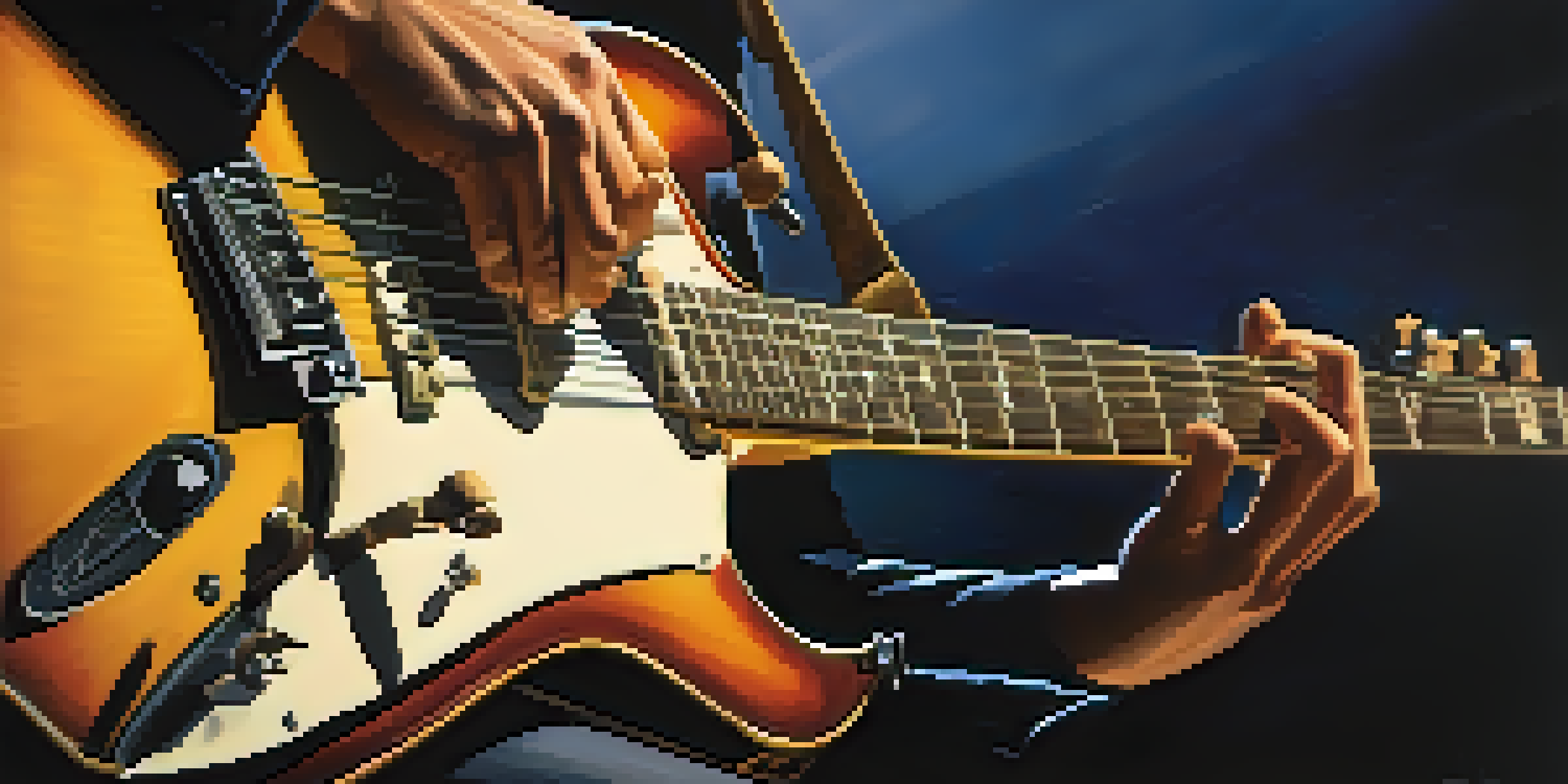Exploring the Use of Harmonics in Guitar Playing Techniques

Understanding Harmonics: What They Are and Why They Matter
Harmonics are special notes created when a string vibrates in a unique way. They occur at specific points along the string, producing a bell-like tone that can add depth and texture to your music. Understanding these notes is crucial for any guitarist looking to expand their sound palette.
Music can change the world because it can change people.
Think of harmonics as the hidden gems of guitar playing; they can transform a simple melody into something truly enchanting. By mastering harmonics, you can create a richer listening experience, captivating your audience and showcasing your skills. This technique can bridge the gap between basic playing and advanced musicianship.
As you dive deeper into the world of harmonics, you'll find that they can be used in various genres, from classical to rock. Whether you're strumming chords or playing intricate solos, harmonics have a place in your toolkit. So, let's explore how you can start incorporating them into your playing.
The Different Types of Harmonics: Natural vs. Artificial
There are two main types of harmonics: natural and artificial. Natural harmonics occur when you lightly touch a string at specific frets, allowing the string to vibrate freely beneath your finger. This technique typically produces a clearer, more resonant sound that can be quite striking in a performance.

On the other hand, artificial harmonics involve fretting a note and then lightly touching the string at a precise point while plucking it. This technique requires a bit more practice but can yield a wide variety of sounds. Both types of harmonics offer unique tonal qualities, enriching your guitar playing in different ways.
Mastering Natural Harmonics
Natural harmonics can be easily produced by lightly touching the string at specific frets, adding a clear, bell-like tone to your music.
Understanding these distinctions is essential for any guitarist wanting to harness the power of harmonics. By experimenting with both natural and artificial harmonics, you can develop a versatile playing style that captivates listeners and keeps your music fresh.
How to Play Natural Harmonics: A Step-by-Step Guide
To play natural harmonics, start by locating the 5th, 7th, and 12th frets on your guitar. Place your finger lightly over the fret (without pressing down) and pluck the string with your other hand. You'll hear a clear, bell-like tone if done correctly—this is the magic of natural harmonics in action!
The beautiful thing about learning is that no one can take it away from you.
It's essential to adjust your finger pressure; too much force will mute the sound, while too little won't generate the harmonic. Practice moving between different frets to explore the range of harmonics available. This exercise can help you improve your finger control and overall technique.
Once you're comfortable with these initial frets, try incorporating natural harmonics into your favorite songs. You might be surprised at how easily they can elevate your playing, adding a layer of complexity and intrigue to even the simplest melodies.
Mastering Artificial Harmonics: Techniques to Try
Artificial harmonics can be a bit trickier to master, but the results are often worth the effort. Start by fretting a note with your left hand and using your index finger to lightly touch the string two frets higher while plucking it with your right hand. This combination creates a beautiful, shimmering sound that can enhance your solos.
Practice this technique slowly, focusing on the precise placement of your index finger. It may feel awkward at first, but with time, you'll find the right balance between fretting and touching the string. As you gain confidence, try incorporating artificial harmonics into your songwriting or improvisation.
Exploring Artificial Harmonics
Artificial harmonics, while trickier to master, allow for a wider variety of sounds and can enhance solos when combined with other techniques.
Artificial harmonics can also be used in combination with other techniques, such as bends or slides. This versatility allows you to create unique musical phrases that stand out, making your playing more expressive and dynamic.
Incorporating Harmonics into Your Guitar Solos
Once you've mastered both natural and artificial harmonics, the next step is to weave them into your guitar solos. Start by identifying moments in your solos where a harmonic could add a unique twist. This could be at the climax of a phrase or as a transition between sections.
Consider using harmonics as a way to build tension or create a dramatic effect. For example, you could play a series of harmonics leading into a powerful chord progression, drawing your audience in and keeping them engaged. Experiment with different placements to see what resonates with your style.
Don't hesitate to let your creativity flow when incorporating harmonics. The more you experiment, the more you'll discover innovative ways to enhance your solos, making each performance feel fresh and exciting.
Famous Guitarists Who Use Harmonics: Inspiration for Your Journey
Many renowned guitarists have successfully incorporated harmonics into their playing, offering inspiration for your own musical journey. Artists like Eddie Van Halen and Joe Satriani have used both natural and artificial harmonics to create iconic sounds that define their styles. Studying their techniques can provide valuable insights into how you might use harmonics in your own music.
Additionally, listening to songs that prominently feature harmonics can inspire your playing. Tracks like 'Eruption' by Van Halen or 'Always With Me, Always With You' by Satriani showcase the beauty and versatility of these techniques, pushing the boundaries of what guitar playing can achieve.
Incorporating Harmonics in Solos
Adding harmonics to your guitar solos can create unique twists and build tension, making your performances more engaging and dynamic.
As you explore these musicians' works, consider how you can adapt their harmonic techniques to fit your unique style. Remember, the goal is to learn from others while developing your own voice as a guitarist.
Tips for Practicing Harmonics: Building Your Skills
Like any other guitar technique, mastering harmonics takes practice. Set aside time in your daily routine to focus specifically on harmonics, breaking down the different techniques into manageable chunks. This approach can help you build confidence and improve your overall skill level.
Incorporating harmonics into your warm-up exercises can also be beneficial. As you play scales or arpeggios, try adding natural and artificial harmonics at various points to familiarize yourself with their sound. This practice not only enhances your technique but also keeps your routine fresh and engaging.

Lastly, don’t be afraid to record yourself while practicing. Listening back can help you identify areas for improvement and track your progress over time. With patience and dedication, you'll find that harmonics can significantly enhance your guitar playing.